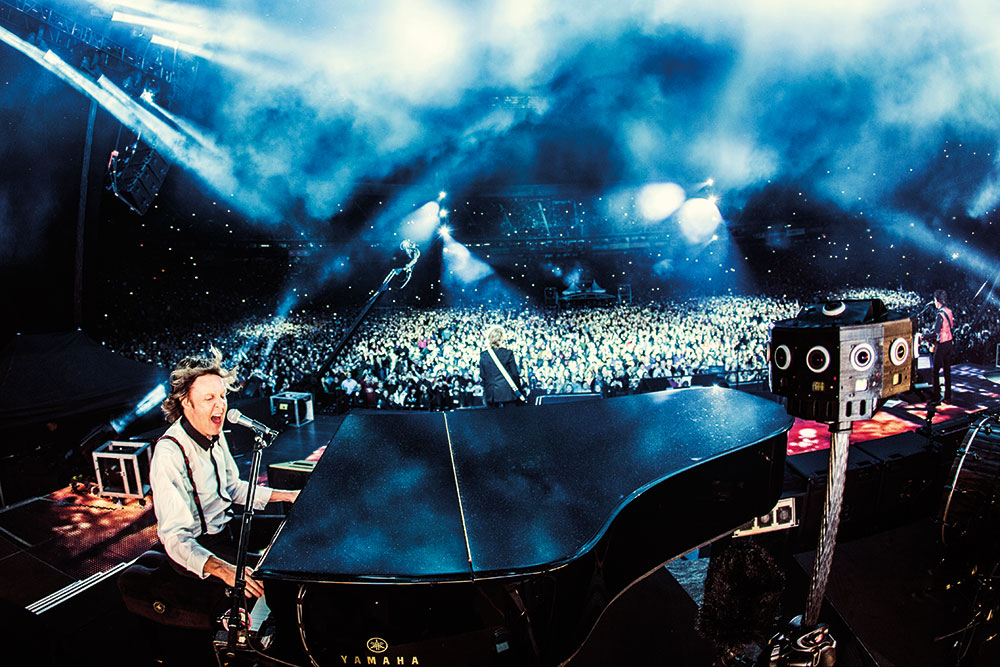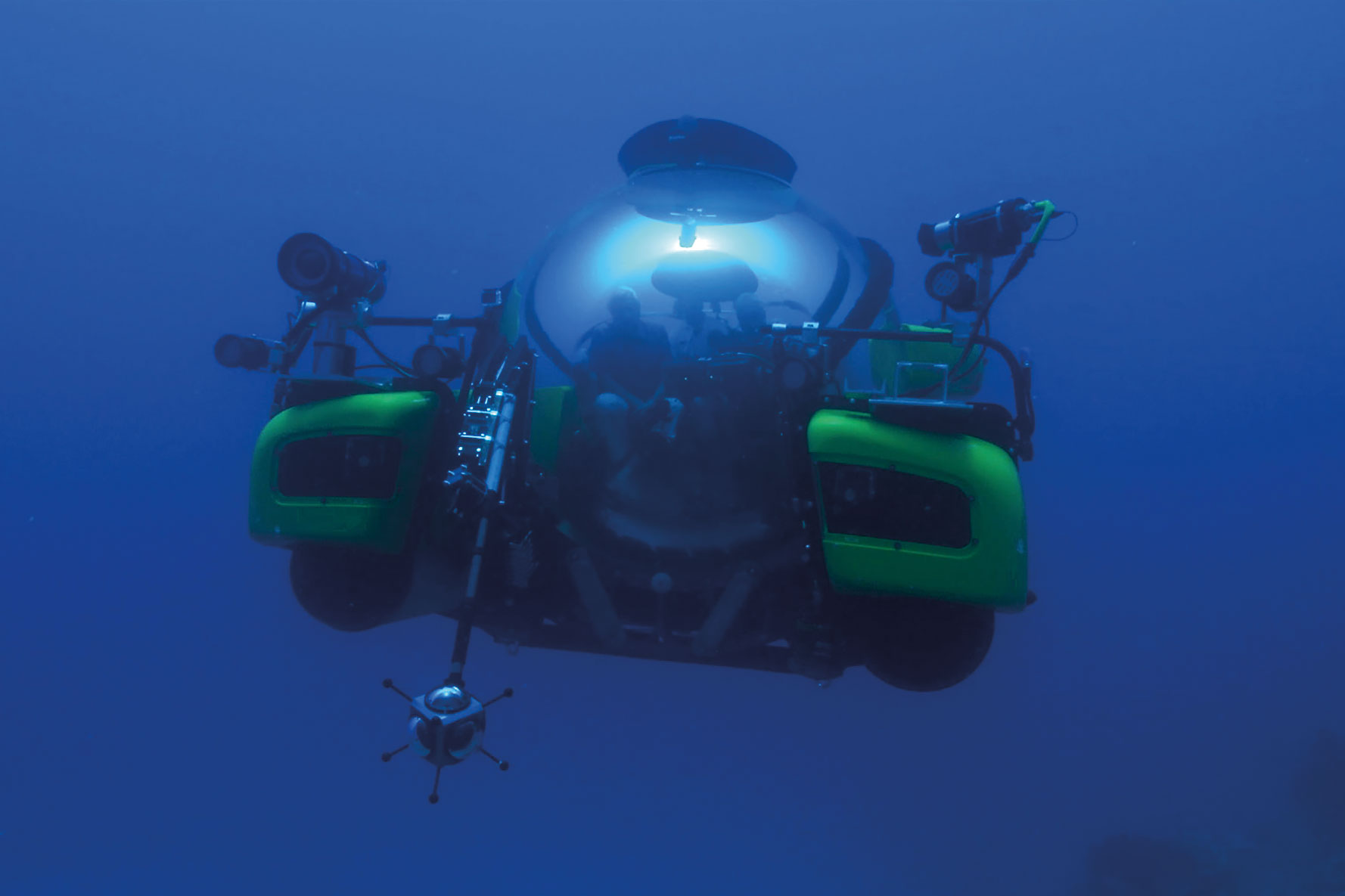
After more than 35 years of operation, TBI is closing its doors and our website will no longer be updated daily. Thank you for all of your support.
Will VR rock in 2016?
 Virtual reality is the talk of the town, with new hardware and a proliferation of apps and experiences launching this year. But what is the business model? Can VR deliver on the hype? How can content companies make money in the fledgling medium? Stewart Clarke dons a headset and finds out
Virtual reality is the talk of the town, with new hardware and a proliferation of apps and experiences launching this year. But what is the business model? Can VR deliver on the hype? How can content companies make money in the fledgling medium? Stewart Clarke dons a headset and finds out
Analysts are divided as to whether 2016 is the year virtual reality takes off, or how many of the new high-end headsets will make it into homes. What is clear is that content companies are placing a bet on the immersive tech.
Franco-German pubcaster Arte, US cable net Syfy and Discovery Communications are among the channel operators getting involved. Netflix and Hulu have launched apps, while content companies including Barcroft TV and Atlantic Productions are making content for VR platforms.
Research by Futuresource Consulting in the US suggests the content that people want most in VR is movies and games, with 39% of consumers sampled interested in experiencing movies, 38% in gaming, and 26% in experiencing VR sports.
Ahead of real-world testing, however, what counts as compelling content remains a moot point. Phil Birchenall, projects director at content trend specialist K7 Media argues that there has to be a very good reason to use VR.
“We need to move away from the idea that using VR will be ‘just another way of watching TV’, which is a huge misconception,” he says. “I’ve seen tests by broadcasters in which they’re just using VR-enabled cameras to shoot a presenter delivering a piece to camera, and that’s not a compelling use of the technology. You have to think about why you’re using a camera in VR, rather than just deciding what to point it at.”
Conceptually, consumers and content companies are undoubtedly fascinated. “VR captures the imagination more effectively than almost any technology from the last two decades, but there is a question about what sort of content will work and engage the consumer,” says Ampere
Analysis research director Guy Bisson. “I’m surprised by the interest and hype, given what happened with 3D. It faces some similar issues to 3D, and a VR headset is considerably more intrusive than a pair of passive 3D glasses. But it is more than hype, and serious players are investing real money into the likes of Jaunt.”
Comcast and Time Warner have invested in VR live-event specialist NextVR, and Disney, ProSiebenSat.1, Sky and Participant Media all contributed to a funding round for Jaunt, the end-to-end VR company that creates cameras and VR tech. It is also working up VR content through its Jaunt Studios division, which is helmed by former Lucasfilm CTO Cliff Plumer.
It plans to launch a VOD VR service this year. “We’re working with brands that want to be involved with good stories, and these are the early sources of funding for content,” Plumer says. “But we’ll be launching more content this year, and testing whether people will pay US$3 to US$9 to download an episode or series.”
The content on the Jaunt app is mostly factual thus far, but it is working with an as-yet-unnamed Hollywood director on an original scripted project, which will likely comprise short eight-to-ten minute episodes for download.
“We’re definitely ramping up,” Plumer says. “Our content comes from partners, but we’ll do some original content this year.”
One of Jaunt’s partners is UK-based Barcroft Media, which runs online channels, and produces for these as well as for linear TV. It will make exclusive content for the Jaunt app after meeting the VR company at MIPTV in 2015. “Immersive 360-degree VR is a whole other creative plane, and a new opportunity to tell stories,” company founder Sam Barcroft says. “But there is a big caveat: no-one has cracked factual in VR in terms of the format. It can be quite full-on, and my first impression is that shorter experiences are more valuable than long ones.”
Facebook and YouTube started supporting 360-degree video last year, and that is where some of the TV players have started their journey to full VR.
Publicly-funded Arte started on its Polar Sea 360 project in 2014 (before Facebook’s 360-degree player was even launched), as a way to present climate change information in a new and engaging way. It is now looking at getting 360-degree content direct to smart TVs, although it is bandwidth intensive.
The early takeaways from Polar Sea included the benefits of real (over CG) images in 360 and VR worlds, says Arte’s coordinator, 360/VR, Kay Meseberg. “I saw that real pictures had much more impact than artificial ones; real pictures captured the 360-degree impact much better, and there is a bigger ‘wow’ effect.”
 Arte has now launched a full-fledged VR app that, as TBI goes to press, has been downloaded 25,000 times. It has a range of content, with Edge of Space (left), a 42km balloon flight experience to the edge of the earth’s atmosphere, the most popular. It was created specifically as an immersive experience, but Meseberg says most of its VR content will relate to an Arte TV show.
Arte has now launched a full-fledged VR app that, as TBI goes to press, has been downloaded 25,000 times. It has a range of content, with Edge of Space (left), a 42km balloon flight experience to the edge of the earth’s atmosphere, the most popular. It was created specifically as an immersive experience, but Meseberg says most of its VR content will relate to an Arte TV show.
New content will be added to the app once or twice a month, and the first scripted offering is about to be added. Philip K. Dick-inspired I, Philip, from Okio Studio and St Georges Studio, follows a human-like android called Phil. Arte’s app is free and as a pubcaster its I, Philip content will be too, but there will be a paid-for Gear VR app launched by the producers.
Immersive entertainment is, however, just one application of VR and numerous other possibilities exist across fields including healthcare, military training, architecture, engineering, travel and retail.
News and sports are also obvious categories for VR experimentation. Sky News in the UK has prepared a VR report on the migrant crisis in Europe, while in the US, ABC News launched a dedicated VR app that was used to take viewers to Syria and North Korea. CBS used VR in February for its news correspondent’s behind-the-scenes report about an unmanned mission to Mars, with the footage added to the Jaunt app.
 Discovery-owned Eurosport has also been testing the medium, with the idea of transporting sport fans to iconic locations or circuits. It worked with ski legend Bode Miller (above) on its first VR video, part of the wider Discovery VR app, and posted it just before a World Cup skiing competition taking place on the same course featured.
Discovery-owned Eurosport has also been testing the medium, with the idea of transporting sport fans to iconic locations or circuits. It worked with ski legend Bode Miller (above) on its first VR video, part of the wider Discovery VR app, and posted it just before a World Cup skiing competition taking place on the same course featured.
“Skiing fans could feel what it would be like to clip into Bode’s skis and race down the Birds of Prey course in Beaver Creek,” says Arnaud Simon, Eurosport’s senior VP, content and production. “For each VR experience it is our ambition to work with passionate, high-profile athletes. and shoot the footage at iconic locations such as the Birds of Prey course or, say, cycling’s Mont Ventoux.”
Boxing matches such as the shortlived (130-second) David Haye and Mark de Mori fight in January have also been captured in VR, with IM360 making a dedicated app for that bout.
K7’s Birchenall cites Discovery VR as one of the apps getting it right. “It is a perfect example of VR being used to add a dimension to content that you’d be unable to without the technology,” he says. “The app showcases specially shot VR content that accompanies Discovery properties such as Mythbusters. So, rather than adopting a whole show for VR, it’s adding something genuinely interesting at a point where VR becomes appropriate.”
Most analysts agree that gaming will be the early driver of uptake of high-end VR headsets. Nintendo is reportedly interested, while Sony’s PlayStation about to enter the fray with PlayStation VR (fka Project Morpheus). A Trojan horse effect, of getting headsets into homes that can then be used for different applications beyond gaming, is thought likely.
So far, however, mass-market VR is mostly a low-end experience via Google’s Cardboard viewer. Google shifted five million Cardboard units between launch in June 2015 and mid-January of this year, but the low-end system can’t deliver the head tracking and advanced features of its high-end peers (although expect updates at the tech giant’s I/O developer conference in May).
Samsung has launched its Gear VR system, which is powered by Facebook-owned Oculus and needs a Samsung smartphone. However, the reason shows such as CES were abuzz with VR gossip and news was that this is the year HTC’s Vive, Oculus Rift, and Sony’s PlayStation system will also roll out, meaning an array of options at the high end of the market.
Analysts at Ovum expect 15-20 million lower- end Cardboard-type devices in the market by end-2016, and about six million higher-end headsets.
“That means VR is no longer in start-up world,” says Ovum’s Paul Jackson, practice lead, media amd entertainment. “This is a landmark year because of the high-end headsets that are coming out.”
A VR report from NATPE and the Consumer Electronics Association, meanwhile, underlined a chicken-and-egg dilemma in VR, whereby content companies want an idea of how they get a return on their investment, while a lack of content potentially hampers sales of headsets.
The report cited significant hurdles to overcome before VR becomes mainstream, “the largest of which is likely the lack of a sustainable model for the creation of content and a clear pathway to monetisation”, it said. “There are also concerns that there will be a lack of quality content once consumers have the hardware in their hands due to cautious investment in content at this beginning phase.”
Anthony Geffen, boss of UK independent producer Atlantic Productions, sees an issue with what can be made, versus what should be made.
“There’s a huge problem coming,” he says. “Everyone is buzzing about the new technology and shooting the heck out of everything, but people want proper stories.”
If there aren’t enough good early experiences the risk is people will say the reality does not match the hype, adds Geffen. “I predict that in six months at MIPCOM people will say there have been few VR successes, and the bubble has burst,” he says. “But the truth is VR is here to stay, in different levels and different places, from apps to institutions.”
 Atlantic was one of the first content companies experimenting with VR, and has set up Alchemy VR, which has collaborated with the Natural History Museum in the UK to create David Attenborough’s Great Barrier Reef Dive, an experience that takes people underwater with the renowned naturalist. Alchemy had the assets from Atlantic-produced BBC doc David Attenborough’s Great Barrier Reef, and also used Jaunt’s system to capture footage. Also coproduced with the Natural History Museum and Attenborough is David Attenborough’s First Life, using Samsung Gear VR headsets to look at the origins of life. Having played with eleven-minute and 20-minute formats, Alchemy says it will now look at a longer half-hour experience. In terms of the model, both were paid-for experiences priced at £6.50 (US$9.40).
Atlantic was one of the first content companies experimenting with VR, and has set up Alchemy VR, which has collaborated with the Natural History Museum in the UK to create David Attenborough’s Great Barrier Reef Dive, an experience that takes people underwater with the renowned naturalist. Alchemy had the assets from Atlantic-produced BBC doc David Attenborough’s Great Barrier Reef, and also used Jaunt’s system to capture footage. Also coproduced with the Natural History Museum and Attenborough is David Attenborough’s First Life, using Samsung Gear VR headsets to look at the origins of life. Having played with eleven-minute and 20-minute formats, Alchemy says it will now look at a longer half-hour experience. In terms of the model, both were paid-for experiences priced at £6.50 (US$9.40).
“As the VR world grows there will be app and online stores, you will be able to create your own experience, and people will download and pay for it,” says Geffen. “However, it is risk money for most people at the moment if you want to do production, because there is no established market.”
Currently, the best bet in terms of recouping investment is working with brands, or – like Alchemy – institutions, but over time a commissioning model is expected to emerge. There will also likely be ad-supported VR and on-demand services and funding models.
Generating revenues is also the responsibility of content companies, K7’s Birchenall says, and they need to deliver content worth paying for.
“The same rules will apply to VR as they do to content we consume currently,” he says. “If it’s an AAA console-style game adapted for VR such as Alien: Isolation, we’ll pay top dollar. If it’s a piece of ancillary content to support a documentary, why should we pay? With Hulu and Netflix both launching apps for VR headsets at the end of last year, it’s clear that subscriptions will form part of the monetisation mix too.”
Marketers certainly see the potential, and novelty value, of VR. Disney and Google launched a Star Wars VR app ahead of The Force Awakens and more Star Wars VR experiences are in the offing after Lucasfilm’s special effects business, Industrial Light and Magic, created the ILM Experience Lab (ILMxLAB) to experiment with the medium. The Martian also had a pre-launch VR app as movie studios wake up to the promotional power of the medium.
Small-screen sci-fi content also lends itself to VR, and NBCU’s Syfy cable net launched immersive and multiplatform unit, Syfy Labs, in January. Syfy had already teamed with tech firm IM360 and launched an app for Google Cardboard last summer based on its original series The Expanse, allowing fans to explore spaceships from the show. A Samsung Gear VR app duly followed.
 Google’s viewer, while not offering the same level of experience as the high-end headsets, is cheap. Syfy gave away 13,000 Cardboard viewers at San Diego Comic-Con when it launched The Expanse app (right).
Google’s viewer, while not offering the same level of experience as the high-end headsets, is cheap. Syfy gave away 13,000 Cardboard viewers at San Diego Comic-Con when it launched The Expanse app (right).
It was innovative marketing for the series ahead of launch, building anticipation and showing fans of the book what the TV show would look like in the process. “A lot of fans had only ever seen the books visualised in cover art, so this showed them we were remaining true [to the spirit of the novels],” says Matthew Chiavelli, senior VP of digital at Syfy. “And because of the timing, last year, there was also a novelty aspect to VR, although I don’t know how long that will last.”
Internationally, Syfy has Halycon, an upcoming drama commissioned for is linear channels and for VR devices, about a virtual-reality-obssessed future world.
The US Syfy is now looking at more guided, narrative VR content “It’s the next step, and no-one has cracked it yet. It is a whole new way to think creatively: the director can’t decide where the viewer looks or what they focus on,” says Chiavelli.
Another obvious but important difference with creating VR, is that TV and film directors are used to shooting what is in front of them, whereas shooting with a 360-degree camera requires everyone out of the scene. One trick is to have the director as an extra, says Jaunt’s Plumer, allowing them to be in the action without ruining the shot.
“People producing content for film, TV or digital are naturally curious to explore VR,” he says. “They can leverage a lot of techniques from those fields, but there is also a whole new language to learn.”
“The skills needed for VR are different to those used today to capture and edit video,” adds Ovum’s Jackson. “It is difficult, for example, to cut between cameras, and you can’t fast-cut.”
Mounting the camera on either side of an athlete’s body, or on an accessory, is a solution in sport, according to Eurosport’s Arnaud Simon. “Some sports lend themselves better to this, but even when it is more challenging we are able to find solutions,” he says. “For the Bode video, the Eurosport team developed a special 3D-printed rig to fix the camera to his ski pole.”
Once filmed, getting content on all platforms, from Facebook and YouTube to Cardboard, and the soon-to-launch high-end headsets, is relatively easy, and content companies understandably want their wares available widely.
“There are two different uses of the technology: the high-class headset experience at one end and the 360-degree video on YouTube and Facebook at the other,” says Sam Barcroft. “We want to do both; we want the large scale recognition at one end, and the reputational benefit at the other.”
 For the Facebook and YouTube end of the market, Barcroft is working with photographer and British 360-degree filmmaker Drew Gardner, who will make a series of short-form docs for the Barcroft TV channel on YouTube, and for Facebook. The first one, Child Climbs Historic Human Tower (above), will follow an attempt to build a 600-person human tower in a Catalan market square.
For the Facebook and YouTube end of the market, Barcroft is working with photographer and British 360-degree filmmaker Drew Gardner, who will make a series of short-form docs for the Barcroft TV channel on YouTube, and for Facebook. The first one, Child Climbs Historic Human Tower (above), will follow an attempt to build a 600-person human tower in a Catalan market square.
With cameras and tech readily available and several new headsets adding to those already in the market, is 2016 the year VR will become a mainstream consumer proposition?
In terms of cold, hard cash it’s unlikely. Futuresource forecasts that the global spend on virtual reality video and games content will be just US$79 million this year. As the array of content to buy grows it projects that will rocket to US$8.3 billion by 2020, making VR a medium-, and certainly not a short-term, play.
In content terms, Arte’s Kay Meseberg highlights a key challenge for the industry. “The chase right now is to find the content that defines the VR category,” he says. “To do for VR what Snow White did for animated film, or Avatar did for 3D.”
Jaunt’s Plumer agrees, and draws a Netflix analogy, noting VR has not yet had its “House of Cards moment”, alluding to the show that helped define the world of streaming. “It’s always driven by content,” he says. “This is the beginning of a whole new medium.”


